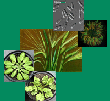| Beck, E; Renner, U: Net fluxes and pools of nitrogenous compounds during suspension-culture of photoautotrophic chenopodium-rubrum cells, Plant, Cell and Environment, 13, 111-122 (1990), doi:10.1111/j.1365-3040.1990.tb01283.x | |
| Abstract: Suspension cultured cells of Chenopodium rubrum were grown photoautotrophically under a diurnal light‐dark cycle of 16‐8h. The following phases of the batch culture were differentiated: a short lag, a cell division phase terminated by a pronounced transition to stationary maintenance which finally gradually passed into senescence. Nitrogen fluxes typical of these stages were followed by measuring uptake of NO3 and NH4+ from the medium and their incorporation into the cellular fractions of nitrogenous compounds. Activities of seven N‐metabolizing enzymes were determined. Compartmentation of enzymes and nitrogenous compounds was analysed after isolation of intact chloroplasts and vacuoles from protoplasts. Eighty‐two per cent of the N originally present in the medium was taken up and incorporated to an extent of 80% into protein until the end of the division phase. Net protein synthesis ceased upon transition to the stationary phase. During the division phase a vacuolar pool of NO3 was established and then maintained throughout the resting phase. Free cellular NH4+ was not localized within the vacuole and responded to the ammonium content of the medium. Amino acids accumulated in the cells especially during the stationary phase, during which they were present in the vacuole. Typical nitrogen relations are portrayed as flux diagrams for one day of each of the essential developmental phases. The enzyme activities were easily sufficient to account for the observed flow rates of the corresponding nitrogenous compounds. Hence, uptake of NO3 and NH4+ must be considered as steps limiting N metabolism in Chenopodium rubrum cell suspensions. |

